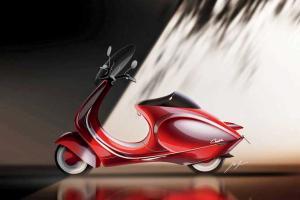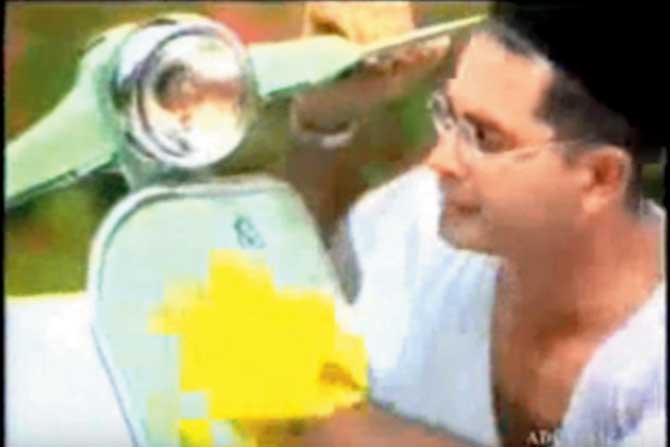With news of an in-the-works electric two-wheeler by Bajaj getting further confirmation, enthusiasts are hoping for the iconic Chetak to make a comeback. Why is the model still a favourite and how would it look in a re-imagined avatar?

Chetak, as reimagined by Rishi Soman for his post-graduation project at the Industrial Design Centre, IIT-Bombay
The thing about nostalgia, when associated with an object, is that it can imbue it with such sentiments that you no longer see it as inanimate. It becomes a living, breathing entity reminding you of the times you touched it, used it, or rode it. That's what the mention of Bajaj Chetak does to countless Indians for whom it wasn't just a scooter but a companion that tirelessly ferried them to office, the market, kids' school, or even far-off picnic spots, year after year, for over four decades.
The Ambassador was the ride of the babus and netas, and the Padmini or Maruti 800 was still a luxury for most households. But the Chetak embraced the Indian family of four with such ease that it inevitably became its fifth member.
ADVERTISEMENT

Which is why, even the faintest hint of the model making a comeback — its production was stopped in 2005 — creates a buzz among automobile enthusiasts. At a recent meeting held at the manufacturer's headquarters in Pune, it was announced that the company is working towards launching an electric two-wheeler in 2020, and rumours are rife that it is likely to be a scooter. The floodgates to nostalgia have opened once again, which is finding an outlet in blogs and on social media platforms.
For Rishi Soman, however, the childhood memories of growing up in the '90s "when every kid aspired to ride a Chetak when he grew up" led him to undertake an academic project when he was a Master of Design student, specialising in Mobility and Vehicle Design at the Industrial Design Centre, IIT Bombay, in 2016. The project, called Restyling the Bajaj Chetak, was supervised by Professor Nishant Sharma. It delved into the history of the model to understand the context and purpose of the design. Existing two-wheeler market and design trends were deliberated, and a target audience of urban youth was set for the new model.

Ethan Fernandes with his 1986 Bajaj Chetak and 1987 Bajaj Super scooters. Pic/Ashish Raje
"There is a concept called the honest design, which is created to solve a problem. The inspiration for Chetak's design lies in the Piaggio, which came into existence to address post-war Italy's need for a modern and affordable mode of transportation for the masses. When a product has an honest design, it talks to people at a subconscious level even if they may not see the technical nuances," shares Soman, who is now a transportation designer.

A still from the Hamara Bajaj commercial of the early '90s
After multiple discussions with fellow designers and scooter users, he arrived at a design which, among other features, retained the model's recognisable engine cowl design, but was more unisex in its appeal. The reimagined avatar was aerodynamically designed and sported a contoured look. Throughout the project, Soman was conscious of not overdoing things. He likens the process to that of recreating an heirloom recipe. "You can add your dash of creativity, but not ruin a classic."
The classic finish of the scooter is what called out to 20-year-old Ethan Fernandes, who saved his pocket money to buy a 1987 model four years ago. "It is the best five grand I have spent so far!" he beams, as he recalls the day he bought it. "The owner reminisced about the time he and his newlywed wife would go to Lonavla on his beloved scooter. He grew misty-eyed as he handed the keys to me, but he was also happy to know that it was in safe hands," he says.

KV Sridhar
What explains these cross-generational sentiments? Ad guru KV Sridhar, who was associated with the iconic Hamara Bajaj ad campaign of the early '90s and its relaunch, explains, "The campaign was launched at a time when India embraced the new economic policy. Indian manufacturers feared the fact that they wouldn't be able to compete with foreign brands. Hamara Bajaj instilled a sense of pride among Indians. It became an anthem of sorts." He adds that even the shift in focus to bikes in the 2000s was communicated through commercials that convinced viewers that the values associated with the Chetak and its era had not been lost.
Sridhar, however, feels that it's best to leave the scooter to the realm of warm and fuzzy memories. "Electric vehicles, given their highly computerised designs, are more a domain of technological companies rather than automobile manufacturers," he says, adding that today's youngsters prefer to 'Uber it' instead of owning a vehicle.

Rishi Soman
But as for Fernandes -- whose love for the scooter rubbed off on to his friend, Rakesh Devadiga, and they jointly bought a second model -- he wouldn't change a thing about his ride. "On a good day, it starts with one kick and on a bad day, it may take 30. But I have never looked at it as a mode of transport," he says. "At traffic signals when I am surrounded by Bullets and other macho bikes, it is my scooter that brings a smile to fellow riders' faces. And in a course of two minutes, decades-old stories come tumbling out."
Catch up on all the latest Crime, National, International and Hatke news here. Also download the new mid-day Android and iOS apps to get latest updates
 Subscribe today by clicking the link and stay updated with the latest news!" Click here!
Subscribe today by clicking the link and stay updated with the latest news!" Click here!







